Attachable toilets: characteristics and popular models
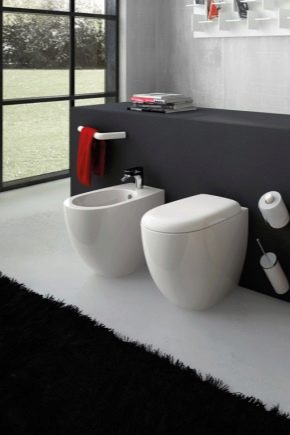
The toilet is an integral part of the bathroom. Recently, models that are mounted close to the wall, the so-called attachments, have been very popular. Their unique design allows you to hide all communications, including the siphon, which allows you to achieve high decorativeness. A variety of models and colors allows you to choose a side-mounted toilet for any bathroom interior: from classics to modern hi-tech and fusion styles.
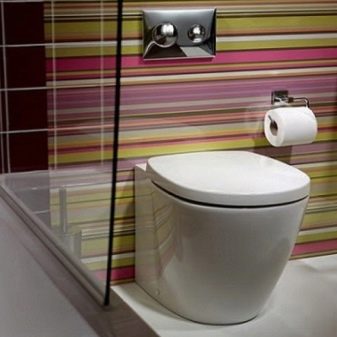
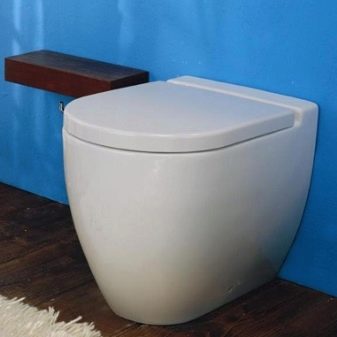
Peculiarities
A side-mounted toilet is a symbiosis of a conventional and a wall-mounted toilet.
As in the latter, all underwater structures are hidden inside the product:
- siphon;
- drain pipe;
- water supply and sewerage system;
- drain tank (on some models).
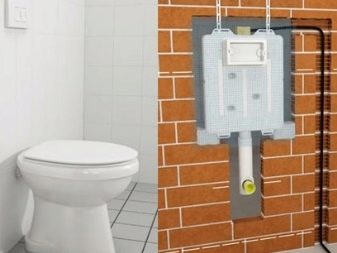
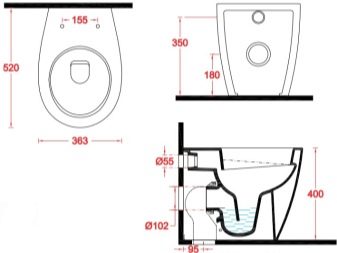
And with a standard toilet, it is related by the similarity of the installation, which even a non-professional can handle. Such a model can be easily used in combined baths and toilets, as well as in restrooms of modest size, since the design can save usable floor space. The support for this toilet is a stand, which makes up one whole with it.
This allows you not to arrange an additional pedestal, which greatly simplifies the installation work.
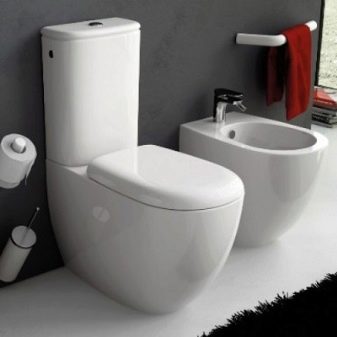

For wall-hung toilets, a support structure is always installed, the cost of which is quite high. The attached toilet does not need to be strengthened, so its installation does not incur additional financial costs, except for the purchase of the product itself and the necessary materials and components.
If the tank is hidden, then it is closed with a false wall. This allows you to achieve high decorative values. Sewer pipes and water supply are supplied separately. Many wall-mounted toilets are equipped with a micro-lift seat that allows the toilet lid to be lowered smoothly, making it more comfortable to use.
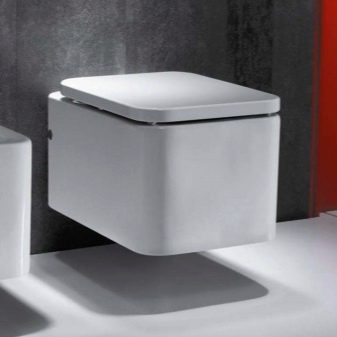
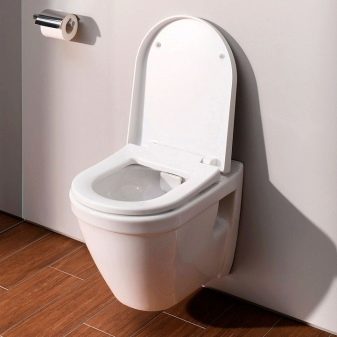
Advantages and disadvantages
Like all toilets, attachment models have their pros and cons.
The disadvantages include the following points:
- the high cost of the product itself, especially in comparison with conventional toilets;
- not budgetary installation;
- if the communications and the tank are hidden, then if they break down, the repair is laborious and expensive;
- lack of free space under the toilet itself, which makes more thorough wet cleaning impossible.
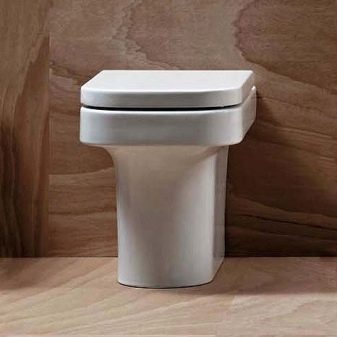
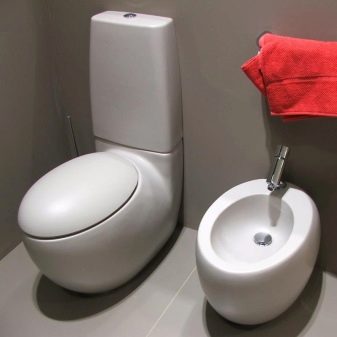
All of these disadvantages are easily compensated for by the undoubted advantages of attached toilets.
- Hidden communications. This allows you to use a side-mounted toilet in any interior, while not violating the harmony of the room and the intended design.
- It takes up significantly less space than a conventional toilet, which is especially important to save valuable space.
- Attachable toilets with a cistern hidden in the wall are virtually silent, as the sounds of the water are muffled by the finish.
- Ergonomic design.
- Durability and reliability. Reliable accessories are supplied with the add-on models.
In addition, well-known manufacturers value their reputation, so the risk of running into a marriage or poor quality is minimal.
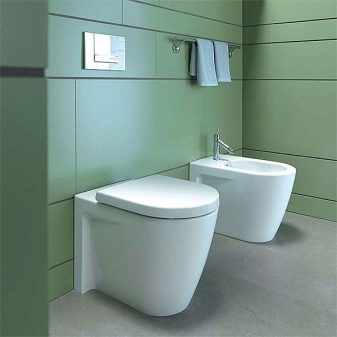
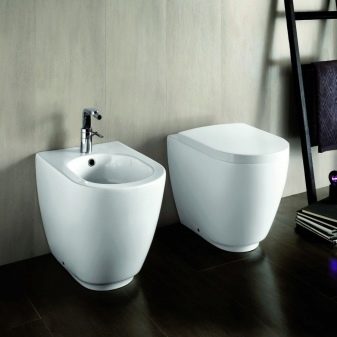
A side-mounted toilet is a modern solution for those who value quality and impeccable appearance. Despite the relatively high cost, especially with conventional models, it fully justifies the funds spent on its purchase and installation.

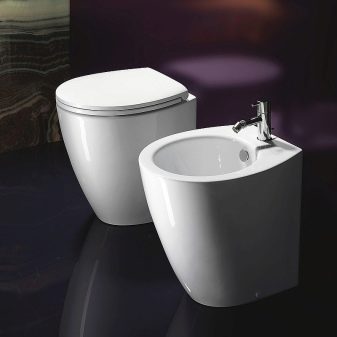
Views
In specialized plumbing stores, it is not difficult to choose a model of an attached toilet bowl that is suitable for each specific restroom. First of all, the differences relate to the exhaust system.
- Straight. The drain pipe is parallel to the floor. This type of release allows you to reliably hide the sewer pipe in the wall.
- Oblique. The axis of the branch pipe is located at an angle of 45º to the floor surface. For a side-mounted toilet with an oblique outlet, the branch pipe is located at the back at the base of the bowl.
- Vertical. The outlet for attached toilets with this exhaust system is located under the toilet.
This type is perfect for private houses and cottages, as well as for old apartments of the "Stalinok" type.
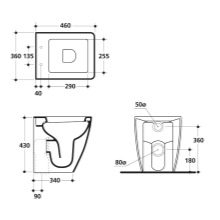

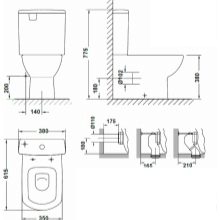
An important point is the difference in the shape of the bowls, because not only the appearance depends on this, but also the convenience of maintaining hygienic cleanliness in the toilet.
- Funnel-shaped. In such a toilet, dirt and, as a result, odors do not accumulate. The point is that waste is immediately sent to the drain valve. But these species have one significant drawback - the formation of splashes, which reduces their hygiene.
- Shelf (plate-shaped). Waste from these types of attached toilets first falls on the shelf, only then is flushed into the drain hole. The disadvantages of this type of toilet bowls include a high water consumption, as well as the deposition of salts in the "platter" and the accumulation of an unpleasant odor.
- Semi-shelf. This is a symbiosis of the first two types of bowls. This option avoids the formation of strong splashes during rinsing and provides easier maintenance and no heavy contamination, in contrast to the dish-shaped models.
This is due to the fact that these models have a shortened version of the shelf.
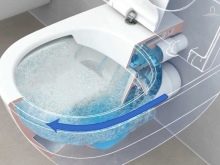
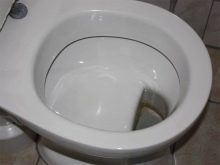
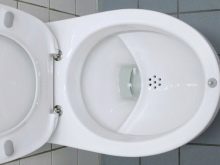
There are three different types of toilet bowls and a drainage system.
- Cascading. This type of drain ensures even washing of the inner surface of the bowl.
- Sucking. Its principle of operation is to pre-fill the bowl with water, and then the waste is discharged downward by opening the drain valve. This type of drainage system is the most powerful.
- Shower room. At the base, water flows are used, which evenly wash the bowl and whirlpool carry away waste.
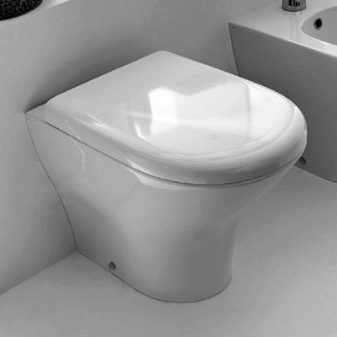
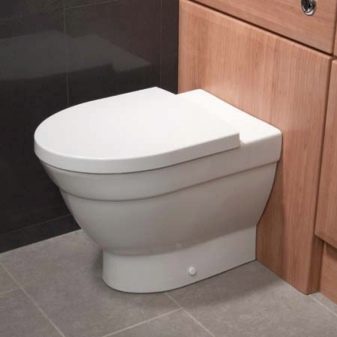
In floor standing toilets, the most common design is with a hidden cistern., but you can find models on which the cistern is installed classically, on top of the toilet. The concealed cistern is usually made of plastic and is shaped like a flat canister. Often, the front wall of such a tank is insulated with foam, which allows a high level of sound insulation and prevents the formation of condensation.
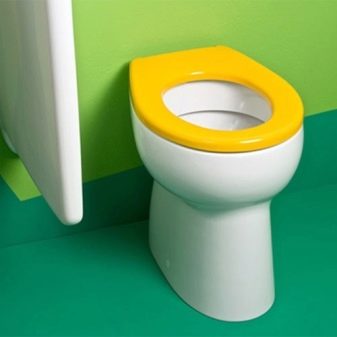
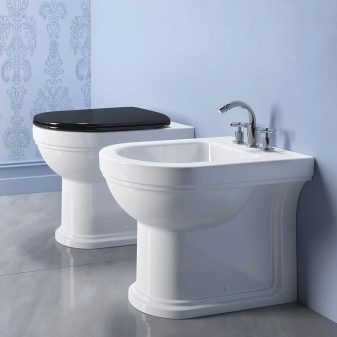
Manufacturing materials and design
Wall-mounted toilets are made from classic materials used in most sanitary ware.
- Porcelain is one of the most durable materials. It is resistant to mechanical and chemical attack, does not absorb odors. Porcelain products are easy to care for, and with careful use, they can last 50 years or more. However, the cost of attached toilets made of this material is very high.
- Faience beautiful, reliable and budget, but cannot boast of a dazzling whiteness like porcelain (even glazed models). It is one of the most popular materials for the production of sanitary ware, including toilet bowls.
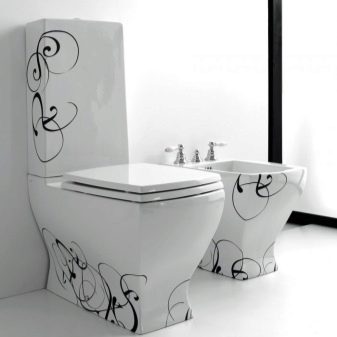

- Stainless steel practically does not occur as a material for the production of home toilet bowls. However, stainless steel models are common, which are installed in public places. Such products are easy to care for, the surface does not absorb dirt, and microbes do not multiply on it, so an unpleasant odor does not form.
- Liquid stone Is a modern material that is gaining popularity.It is a polymer concrete with various color additives, which make it possible to very accurately imitate the color of natural materials.
- A natural stone although rare, it is used for the production of toilet bowls. The fact is that the cost of such plumbing is quite high, but the consumer properties leave much to be desired in comparison with faience or porcelain. The surface of natural stone is very sensitive to chemical and mechanical stress, and microbes and bacteria, including dangerous ones, thrive on it.
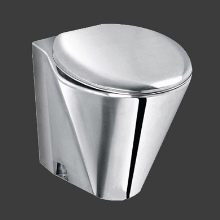
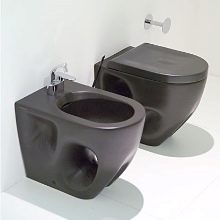
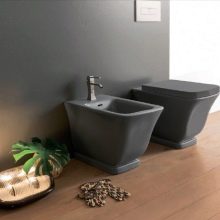
Popular models and brands
A huge number of models of both foreign and domestic production are presented on the plumbing market.
The following brands of toilet bowls are in greatest demand:
- Belbagno Alpina;
- Cezares Royal Palace;
- Villeroy & Boch;
- Kerasan;
- Sanita.

Belbagno, Kerasan and Cezares Royal Palace Are Italian companies producing sanitary ware in the middle and premium price segment. Their products are distinguished by their laconic forms and a variety of models. Traditionally, Italian side-to-side toilets are considered the best. It's all about the quality of the materials used, as well as reliable components.
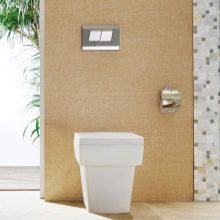

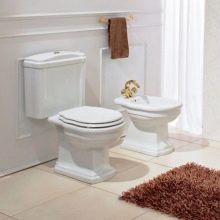
Villeroy & Boch Is a German company founded more than 250 years ago and is rightfully considered the world leader in the production of sanitary ware. The main advantage is the combination of comfort, laconic design and functionality. There are no negative reviews for Villeroy & Boch products, the quality of the manufactured plumbing is so high.
Sanita Is a Russian company that represents sanitary ware in an economy and an average price budget. Most of the models are made from earthenware at a factory in the city of Samara.
The wall-mounted toilet from Sanita is a great budget option with an interesting design.
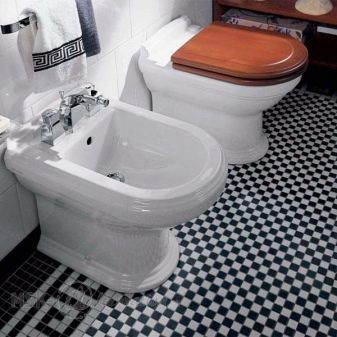
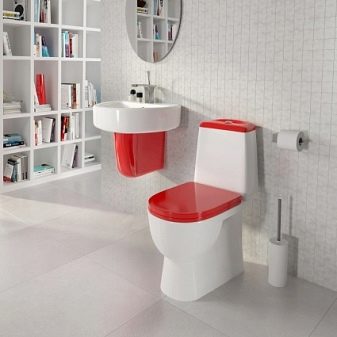
How to choose?
When choosing an attached toilet, the price is the last thing to pay attention to, since it will not work very cheaply to buy a standing model.
In order not to be mistaken with the choice, you should pay attention to the following points:
- the exhaust system must correspond to the type of sewage system, as well as the size of the socket. Otherwise, the toilet simply cannot be installed correctly;
- the material of manufacture can be any, but it is better to give preference to stainless steel, porcelain or faience.
They are easy to care for, and they are also resistant to detergents, including aggressive ones;
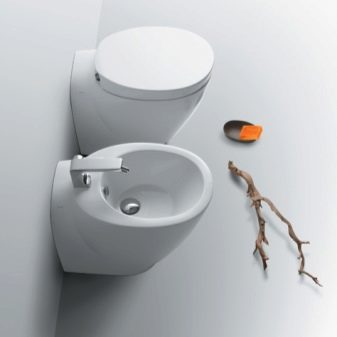

- valves that provide flushing are pneumatic and cable (lever and cable). The latter is more reliable and will last longer;
- the dimensions and dimensions of the toilet itself must correspond to the "weight" category of the future owners. If you do not "try on" the attached toilet, it may turn out that it is not very convenient to use it;
- the manufacturer is also no less important, so it is better to trust trusted brands.
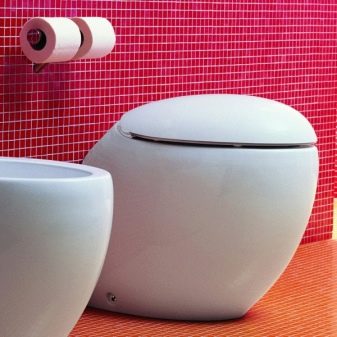

Installation tips
When installing an attached toilet yourself, the following subtleties should be considered:
- first, the installation of a hidden cistern and sewer works are carried out, and after that - finishing;
- to connect to the sewer, it is recommended to use a rigid liner and be sure to use a high-quality sealant, then the connection will not flow;
- the liner is installed taking into account the pipes at the level in order to prevent leaks in the future;
- if the drain button has a mechanical pull (cable and lever), the wall thickness should be about 7 centimeters;
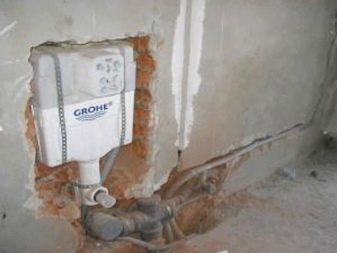
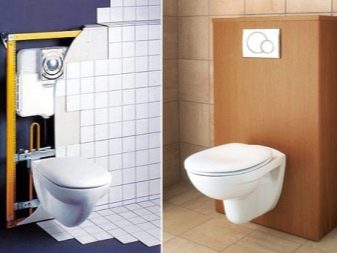
- they begin to lay tiles from the button;
- if possible, it is better to install a double drain button, which will save water and reduce the formation of condensation on the tank;
- you should not save on accessories and fasteners, especially if the tank is hidden, since repairs will be difficult;
- to simplify repairs, some craftsmen build a hatch or false wall, which greatly simplifies the task in case of unforeseen situations.

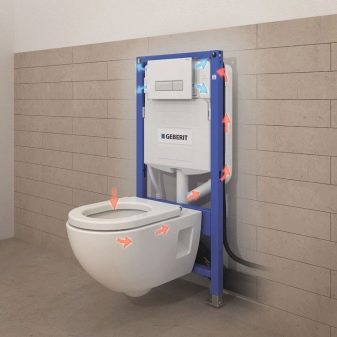
A side-mounted toilet is a modern and stylish solution for those who decide to renovate the bathroom.With it, you can safely experiment with styles and finishes, and a large selection of models will allow you to choose the best option for any design.
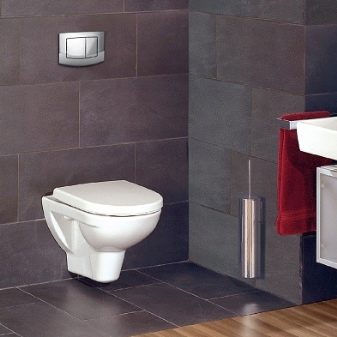
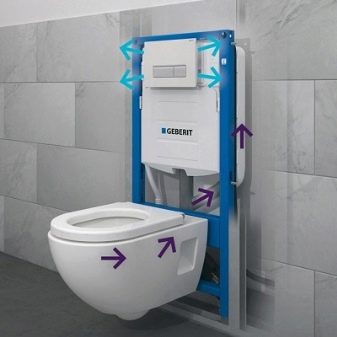
You can find out how the attachment toilet is assembled from the video below.













The comment was sent successfully.